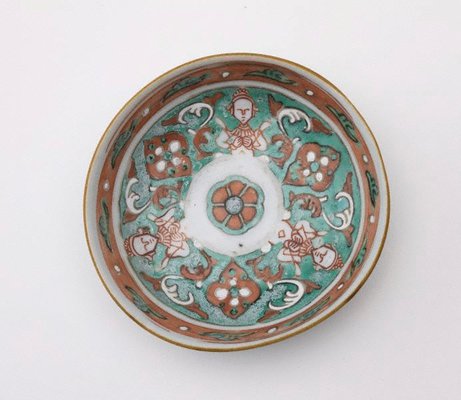-
Details
- Other Titles
- Small dish decorated in red, green and white enamels with thepanom interspersed with rhomboids
Bowl decorated with thepanom and norasingh - Place where the work was made
-
Thailand
- Period
- Rama I Period 1782 - 1809 → Thailand
- Media category
- Ceramic
- Materials used
- porcelain with red, green and white enamel decoration
- Dimensions
- 20 cm diam.
- Credit
- Gift of Mr F. Storch 1987
- Location
- Not on display
- Accession number
- 446.1987
- Copyright
- Artist information
-
Bencharong ware
Works in the collection
- Share
-
-
About
Bencharong ware is a polychrome porcelain initially made in the city of Jingdezhen (the porcelain capital of China) where it was richly decorated to Thai tastes with bright enamel glazes. It is thought that Buddhist books and paintings were supplied as references and sent to Guangzhou (Canton) merchants, who acted as intermediaries to the Chinese potters and decorators for foreign orders. As with orders for Europe, new ceramic shapes were communicated by maquettes in wood or perhaps metal. While the name Bencharong derives from the sanskrit words ‘pancha’ and ‘ranga’ meaning five colours, Bencharong wares can also be found with as few as three and as many as eight colours.
Bencharong wares were first commissioned by the Thai kings of Ayutthaya in the 18th century during a peaceful period of rule that was congenial to picnics and tours and where Bencharong wares could be used to store and serve food. After the fall of Ayutthaya to the Burmese in 1767 Bencharong wares became more widely used and Lain Nam Thong wares superseded them as the exclusive wares of royalty.
This bowl is decorated with alternating images of 'thepanom' and a rhomboid floral pattern. The 'thepanom', celestial beings who live in one of the six lower Buddhist heavens, are minor deities in Theravada Buddhism. Here they are depicted sitting cross-legged in a praying posture, nude except for a petalled collar, bracelets and crown.
Asian Art Department, AGNSW, Dec 2015
Bencharong ware is a polychrome porcelain made in the city of Jingdezhen (the porcelain capital of China) and richly decorated to Thai tastes with bright enamel glazes. It is thought that Buddhist books and paintings were supplied as references and sent to Guangzhou merchants, who acted as intermediaries to the Chinese potters and decorators for foreign orders. As with orders for Europe, the desired ceramic shapes were communicated by maquettes in wood or perhaps metal. While the name Bencharong derives from the sanskrit words ‘pancha’ and ‘ranga’ meaning five colours, Bencharong wares can also be found with as few as three and as many as eight colours.
Bencharong wares were first commissioned by the Thai kings of Ayutthaya in the 18th century. This period of relative peace saw rulers enjoy picnics and tours with Bencharong wares used to store and serve food. After the fall of Autthaya to the Burmese in 1767, Bencharong wares began to be used by the wider community and Lain Nam Thong wares superseded them as the exclusive wares of royalty.
This bowl is decorated with alternating images of 'thepanom' and a rhomboid floral pattern. The 'thepanom', celestial beings who live in one of the six lower Buddhist heavens, are minor deities in Theravada Buddhism. Here they are depicted sitting cross-legged in a praying posture wearing only a petalled collar, bracelets and a crown.
-
Places
Where the work was made
Thailand
-
Bibliography
Referenced in 1 publication
-
Jackie Menzies, AGNSW Collections, 'Asian Art - India, South-East Asia, China, Tibet, Korea, Japan', pg. 173-228, Sydney, 1994, 183 (colour illus.).
-





